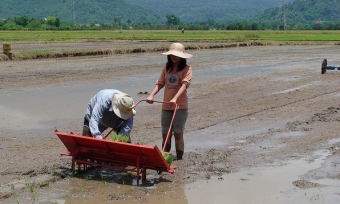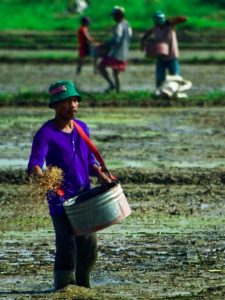
Rice farmers all over the world are using new and improved technologies. And, to some degree, these technologies have helped keep many of the world’s poor from being pushed further down the road to poverty. An example is IR8, the media dubbed “miracle rice,” developed by the International Rice Research Institute (IRRI) in the mid-1960s. Average rice yields before IR8 was available to farmers were 2 tons per hectare. The arrival of IR8, which produced yields that could be 9.5 to 10.5 tons per hectare, changed the trajectory of humanity’s poor, especially in Asia.
This pivotal rice variety has found a deserved niche in the annals of humanity’s efforts to feed itself as part of the Green Revolution. “In the early years following the Green Revolution, we did not have to pay much attention to profit,” says Kei Kajisa, IRRI senior scientist and socioeconomist from the International Rice Research Institute (IRRI). “Yield-maximizing recommendations matched farmers’ profit maximization objectives, too. Today, with different factors affecting rice-farming practices, high yield does not necessarily result in high profit. Sometimes, whether farmers make a profit or not is tied to their management or the choices that they make.”
As time marches on, it has become clear that there is no shortage of lessons to be learned and, consequently, there are opportunities to grab and exploit. Achim Dobermann, IRRI’s deputy director general for research, thinks that if a given technology helps farmers to garner robust profits, it will spread quickly. “But, we have to understand that farmers make decisions on how to maximize profit and minimize risk,” says Dr. Dobermann, “and this decision-making happens for a whole sequence of crop management operations. These decisions can lead to incremental gains–or losses–as the success of a single technology may also depend on other decisions farmers make.”
Today’s weighing game

Dr. Kajisa and his team have been studying farming communities in the Philippines, China, and India, as well as getting insights and trends from four decades’ worth of grass-roots socioeconomic information.
“Now, some farmers choose field practices to maximize their profit, but these practices do not necessarily result in increasing their yield,” says Dr. Kajisa. “When IRRI was established in 1960, there were adequate resources (such as water and labor), but technology was lacking. Today, we see a reversal in that many technologies are available, but water and labor are becoming alarmingly scarcer. In addition, there has been a sudden urgency to develop modern rice varieties that can cope with climate change.”
Dr. Kajisa points out that when water becomes scarce in a farming community, it is important for members of that community towork together to maintain their water source and to develop a water rotation scheme among themselves.“There is also potential to use volumetric pricing for efficient water use within a community,” he says. “With this, farmers will pay less when using less water and pay more for increased water use, which should be offset by a higher crop yield.
“On the labor-scarcity front, Dr. Kajisa’s study found a new developing trend in farmers’ practices—the casualization of labor.There is now a general decline in attached or permanent labor and an increase in outsourcing or non personalized labor arrangements. This is becoming common in many parts of South and Southeast Asia.
“Casualization is problematic because the rice crop requires rigorous attention,” says Dr. Kajisa.“Some farming practices are better implemented when farmers are present themselves or they have trusted permanent laborers on site who will conduct activities honestly.”
Ultimately, most farmers will find ways to cope with water and labor scarcities to maximize their profits, but yields might suffer as a result. As Dr. Kajisa observed in China, one location had a successful community-managed water source but high labor costs due to scarcity. So, to save money, the farmers decided to broadcast or direct-seed instead of transplanting seedlings. Because of this decision, yields decreased, but, in the end, the labor savings still allowed the farmers to turn a profit.
In the Philippines, farmers are also inclined to direct-seed their crop. “They decide to do this, not because it is a proven practice resulting in high yield, but because it saves on labor costs,” says Piedad Moya, IRRI socioeconomist. “Transplanting seedlings would force them to hire more laborers to do the job. With direct seeding, they can sow the seed themselves in 1 day.” Ms. Moya, a member of Dr. Kajisa’s team, is also involved in IRRI’s decades-old household survey designed to gather grass-roots information on farmers from all over Asia.
For farmers, not scientists
The findings of Dr. Kajisa’s team draw attention to what drives a farming community to come together to manage a scarce resource such as water or how to cope with rising labor costs. These decisions are very much shaped by the fact that everyone is no stranger to profit. This is logical because farmers’ take-home income translates into having adequate food, education, and medical security for their families.
These findings have given researchers and extension workers something to think about.
“My own rule-of-thumb has always been that most farmers will be interested in a new technology only if it is easy to understand and apply—and if it increases their profit by at least US$50 per hectare,” says Dr. Dobermann. “I have observed that many technologies may sound good in theory or do well in a carefully designed research trial, but they don’t necessarily meet farmers’ expectations in the field.”
IRRI researchers are not only breeding new rice varieties that are high-yielding, are stress-tolerant, and have good grain quality, but they are also developing and evaluating crop management technologies that are environmentally sustainable and cost reducing.
“Farmers are always keen to look for better ways to grow their crop, as long as they have access to new information,” explains Dr. Dobermann. “One of IRRI’s roles is to get this information to them as rapidly as possible. We need to use the available information channels and forge private and public partnerships to make sure that what we do is driven by the needs of farmers, not the needs of scientists.”
IRRI’s research chief thinks that the Institute needs to focus more and more on finding solutions that involve truly integrated crop and cropping systems management under real-world field conditions.






